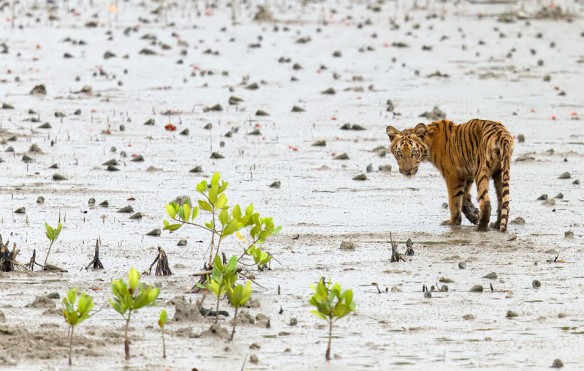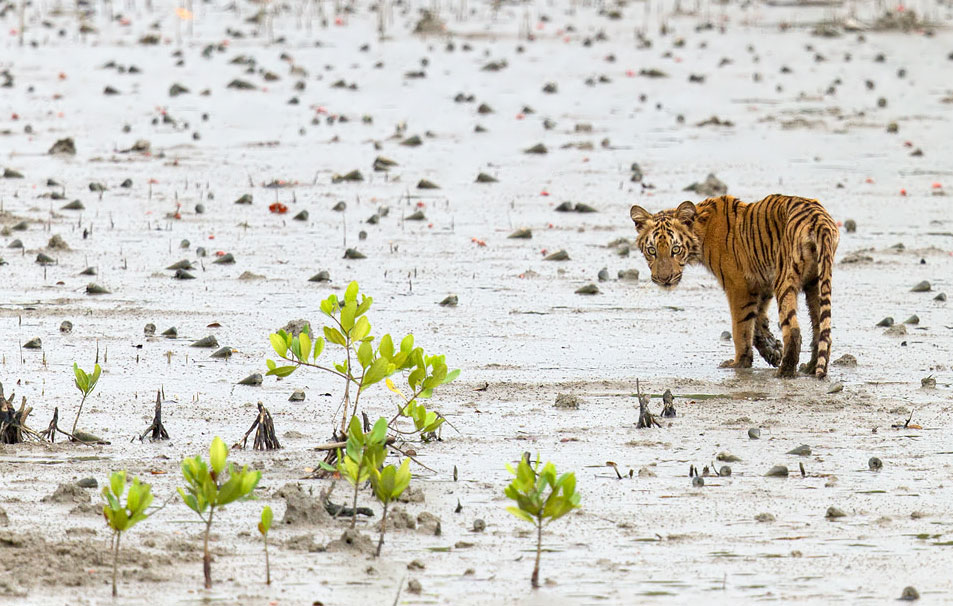
Sundarbans. Photo source: ©© Arindam Bhattacharya
Excerpts;
Toxic chemical pollution in the Sundarbans, the largest mangrove forest in the world, is threatening thousands of marine and forest species and has environmentalists deeply concerned about the future of this World Heritage Site.
Repeated mishaps have already dumped toxic materials like sulfur, hydrocarbons, chorine, magnesium, potassium, arsenic, lead, mercury, nickel, vanadium, beryllium, barium, cadmium, chromium, selenium, radium and many more into the waters. They’re killing plankton – a microscopic organism critical for the survival of marine life inside the wild forest.
Scientific studies warn the sudden drastic fall in the plankton population may affect the entire food chain in the Sundarbans in the near future, starving the life in the rivers and in the forest.
The latest incident involved the sinking of a coal-loaded cargo ship on April 14 deep inside the forest, popularly known as the home of the endangered Royal Bengal Tigers, once again outraging environmentalists…
Read Full Article; IPS News (05-19-2018)
A new power plant could devastate the world’s largest mangrove forest; The Washington Post (07-18-2016)
The planet’s largest mangrove forest could be facing serious trouble in the form of two new coal-fired power plants, environmentalists say — and they’re urging the United Nations to draw greater attention to the issue…
How Not to Love Nature: Shove a Coal Plant Next to Earth’s Biggest Mangrove Forest; World Time (10-06-2013)
Tigers have long provided the best defense for Bangladesh’s Sundarbans National Park, the planet’s largest mangrove forest and a UNESCO World Heritage site. These days, however, environmentalists are alarmed by a more insidious threat to the park’s future: a massive 1,320-MW coal-fired power plant that’s due to be constructed just 14 km away, in the city of Rampal…
Maersk in hot water for sending ships to notorious scrapping beaches; CPH Post Denmark, (10-17-2016)
While outwardly against the procedure, 14 ships of the Danish oil and shipping company Maersk, were being broken up on open beaches in India and Bangladesh…
The Ship-Breakers, National Geographic (05-2014)
In Bangladesh men desperate for work perform one of the world’s most dangerous jobs…
Breaking Bad on the Beach, NASA / Earth Observatory (09-28-2014)
Tens of thousands of ships ply the world’s oceans, bays, and rivers. But what happens when those ships have become too old or too expensive to operate? In most cases, they end up on the shores of Asia…literally…
“FREIGHTENED – The Real Price of Shipping,” a movie by multi award-winning filmmaker Denis Delestrac-©-2016; (03-31-2016)
90% of the goods we consume in the West are manufactured in far-off lands and brought to us by ship. The cargo shipping industry is a key player in world economy and forms the basis of our very model of modern civilisation; without it, it would be impossible to fulfil the ever-increasing demands of our societies. Yet the functioning and regulations of this business remain largely obscure to many, and its hidden costs affect us all. Due to their size, freight ships no longer fit in traditional city harbours; they have moved out of the public’s eye, behind barriers and check points…









